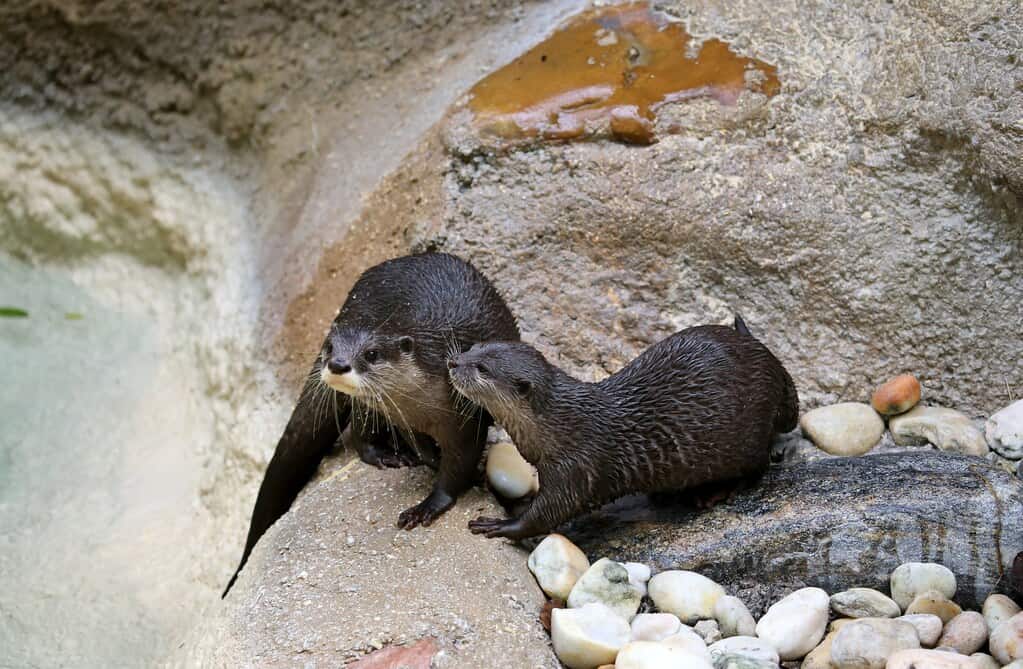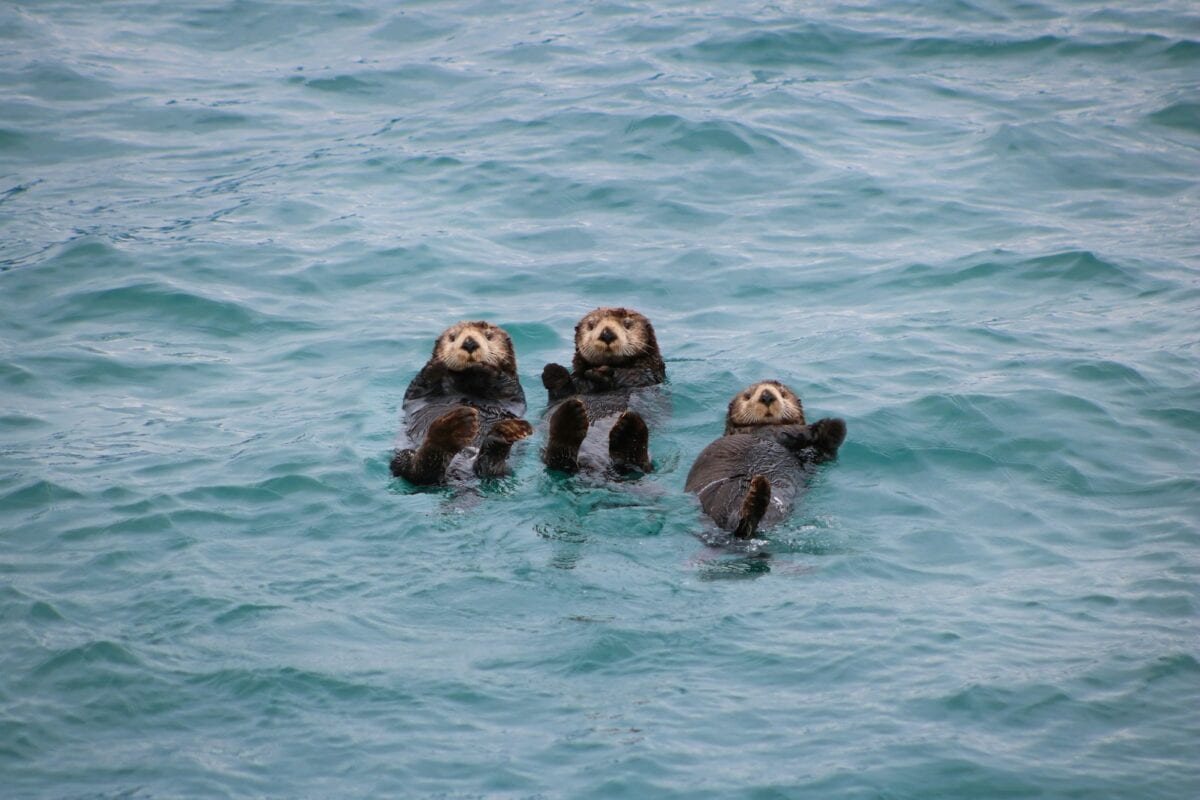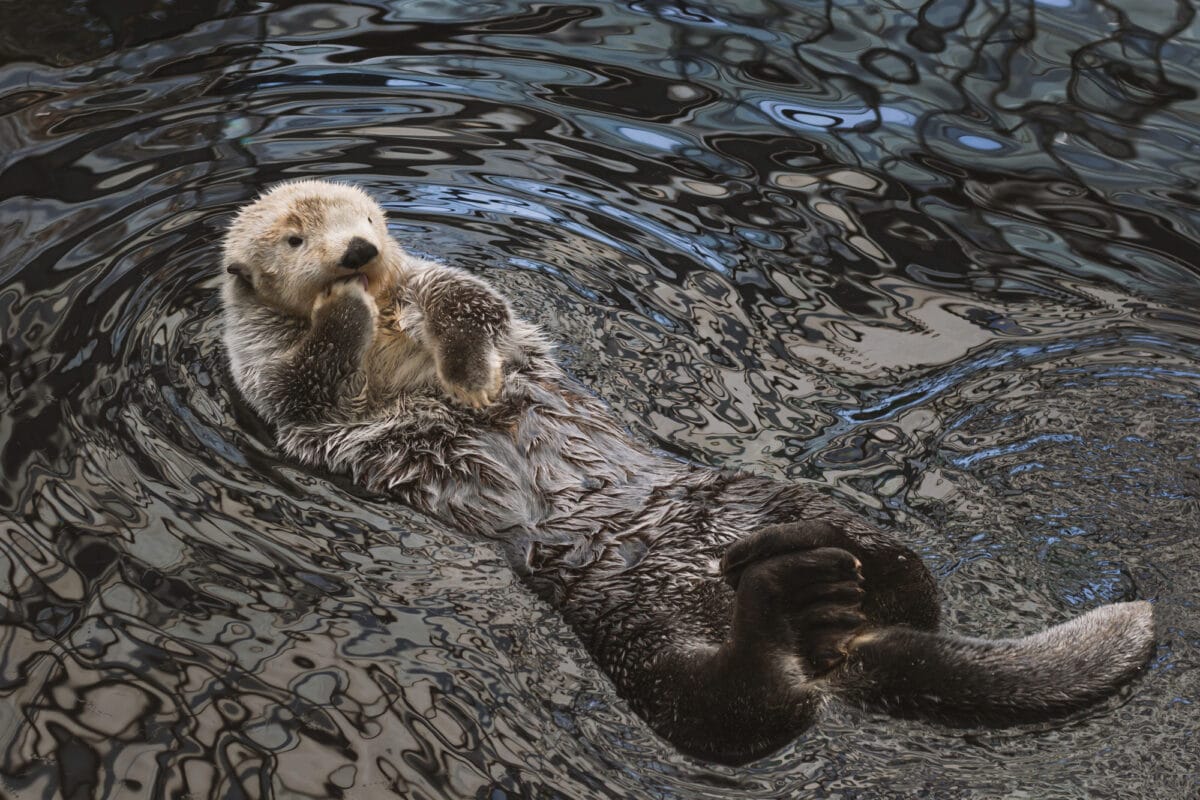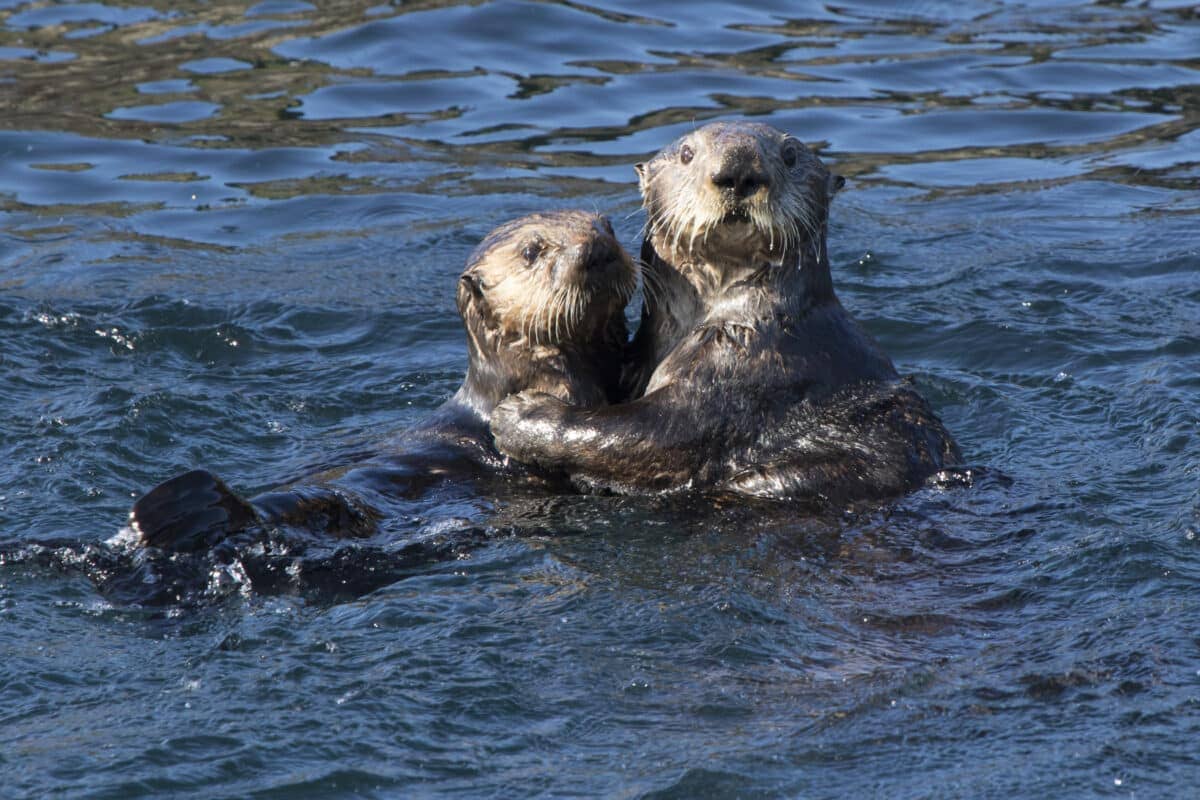Among animal behaviors, few actions capture human hearts quite like sea otters holding hands while sleeping. This endearing habit isn’t just an anthropomorphic interpretation of random animal behavior – it’s a genuine survival adaptation that serves essential purposes in otter communities. This article explores the fascinating world of otters, focusing on their famous hand-holding behavior, the science behind it, and what it reveals about these remarkable marine mammals. From evolutionary advantages to social implications, we’ll dive into why this behavior has made otters internet sensations and important symbols of wildlife conservation.
The Science Behind Otter Hand-Holding

Sea otters (Enhydra lutris) engage in a behavior scientists call “rafting,” where groups of otters float together on their backs while resting or sleeping. During these periods, they often hold paws or “hands” with one another. This isn’t merely cute; it’s functional. Biologists have observed that this behavior prevents the otters from drifting apart while sleeping in the water.
Sea otters lack the blubber layer that other marine mammals use for insulation, making it crucial for them to stay together for warmth and safety. By linking paws, they ensure their small family groups or colonies remain together despite ocean currents and tides. Research from the Monterey Bay Aquarium has documented that otters may drift up to 100 kilometers if not anchored somehow, making hand-holding an essential survival strategy.
Different Otter Species and Their Sleeping Habits

While sea otters are famous for holding hands while sleeping, this behavior isn’t universal across all 13 species of otters. The hand-holding behavior is most commonly observed in sea otters (Enhydra lutris), particularly those living along the Pacific coast of North America. River otters (Lontra canadensis), for instance, typically sleep on land in dens they build near riverbanks, eliminating the need for hand-holding.
Asian small-clawed otters (Aonyx cinerea), the smallest otter species, sleep in family groups but don’t typically exhibit the hand-holding behavior. Each species has evolved sleeping strategies suited to their habitat and lifestyle. The giant otter (Pteronura brasiliensis) of South America, for example, sleeps in family groups on riverbanks rather than floating in water. These variations reflect the diverse evolutionary paths otters have taken across different environments worldwide.
Kelp: Nature’s Otter Anchor

In addition to holding hands, sea otters have developed another ingenious method for staying put while sleeping: using kelp as natural anchors. In kelp forest ecosystems along the Pacific coast, otters will wrap themselves in strands of kelp that grow from the ocean floor to the surface. This behavior serves as a secondary or sometimes primary anchoring system when hand-holding isn’t possible or sufficient. The kelp effectively acts as a natural tether, preventing the sleeping otter from drifting away with the currents or tides.
This relationship highlights the intricate ecological connections in marine ecosystems – the same kelp forests that otters use for anchoring are also protected by otters, who eat sea urchins that would otherwise devastate kelp populations. Scientists from the University of California, Santa Cruz have documented how this behavior varies seasonally, with otters using kelp anchoring more frequently during stormy winter months when water is more turbulent.
Mother-Pup Bonding Through Hand-Holding

The hand-holding behavior takes on special significance between mother sea otters and their pups. A newborn sea otter pup cannot swim for the first few weeks of life, making the mother’s care essential for survival. Mother otters are exceptionally attentive, often holding their pup’s paws while the baby sleeps on the mother’s chest. This not only prevents the vulnerable pup from drifting away but also reinforces the strong bond between mother and offspring.
The behavior has practical benefits too – by holding their pup close, mother otters can groom their fur, helping to maintain the air trapped in the pup’s coat that provides crucial buoyancy and insulation. This intensive maternal care period lasts about six months, during which the mother teaches her pup essential survival skills including how to groom, find food, and eventually, the social behavior of rafting and hand-holding with other otters. Research published in the Journal of Mammalogy indicates that this extended maternal care period is among the most intensive of any marine mammal relative to body size.
The Social Implications of Otter Hand-Holding

Beyond the practical purpose of staying together, hand-holding in sea otters reflects their highly social nature. Sea otters typically live in single-sex groups called rafts, which can contain anywhere from 10 to 100 individuals, though they’re most commonly seen in smaller family units. Within these communities, hand-holding reinforces social bonds and group cohesion. Interestingly, researchers have observed that otters tend to hold hands more frequently with familiar individuals, suggesting preference and recognition within their social groups.
This behavior may help reduce stress among group members, as physical contact in many mammals is known to release oxytocin, often called the “bonding hormone.” Studies from the Seattle Aquarium have shown that otters in captivity will seek out specific partners for rafting and hand-holding, further indicating that this behavior has social significance beyond mere practicality. These observations align with what scientists understand about the complex social structures of many marine mammals, where physical contact plays a crucial role in maintaining group harmony.
The Evolutionary Advantage of Hand-Holding

From an evolutionary perspective, the hand-holding behavior represents a remarkable adaptation that provides sea otters with several survival advantages. Sea otters evolved from land-dwelling ancestors approximately 5 million years ago, developing unique traits to survive in marine environments without the thick blubber layer that insulates other marine mammals. By holding hands while sleeping, otters reduce heat loss through group thermoregulation, particularly important since they have the densest fur of any animal (with up to one million hairs per square inch) rather than blubber for insulation.
This behavior also reduces energy expenditure – floating requires less energy than swimming, and staying together through hand-holding means less energy spent finding the group after drifting apart. Additionally, the behavior increases vigilance against predators like orcas and great white sharks, as multiple otters are more likely to detect danger than solitary individuals. Evolutionary biologists point to this behavior as a classic example of how social behaviors can provide fitness advantages, ultimately becoming fixed in a species through natural selection.
Cultural Impact and Human Connection

The image of otters holding hands has transcended scientific interest to become a powerful cultural symbol. Since the early 2000s, with the rise of social media, photos and videos of hand-holding otters have gone viral repeatedly, becoming internet sensations and inspiring countless memes, greeting cards, and merchandise. The behavior resonates deeply with humans because it appears to mirror our own expressions of affection and connection. This anthropomorphic interpretation, while scientifically imprecise, has helped foster public interest in otter conservation.
Vancouver Aquarium researchers noted a 300% increase in donations to their otter conservation programs following a viral video of otters holding hands at their facility in 2007. The cultural impact extends to relationship symbolism – some couples even reference “otter hand-holding” as a relationship goal or symbol of enduring partnership. While biologists caution against excessive anthropomorphism, they acknowledge that this emotional connection has been beneficial for raising awareness about the ecological importance of otters and the threats they face.
Threats to Otter Populations

Despite their internet popularity, sea otters face significant conservation challenges. Historically hunted to near extinction for their luxurious fur during the maritime fur trade of the 18th and 19th centuries, sea otter populations dropped from an estimated 300,000 worldwide to fewer than 2,000 by the early 1900s. Though protected by the International Fur Seal Treaty of 1911 and listed as endangered under the Endangered Species Act in the United States, sea otters still face numerous threats.
Oil spills pose a particular danger, as they can destroy the insulating properties of otter fur, leading to hypothermia and death. Environmental pollutants, fishing gear entanglement, habitat degradation, and climate change impacts on kelp forests and shellfish populations further threaten these animals. According to the U.S. Geological Survey, while some populations in Alaska and California have rebounded, others remain perilously low, with the southern sea otter population hovering around 3,000 individuals – well below historical numbers. Their endearing behaviors, including hand-holding, have become powerful symbols for conservation efforts aimed at protecting these charismatic marine mammals.
Otter Sleep Patterns

Sea otters display fascinating sleep patterns that differ significantly from most mammals. Unlike many land animals that sleep for extended periods, sea otters typically engage in polyphasic sleep – multiple shorter sleep episodes throughout a 24-hour period, usually lasting 1-2 hours each. This adaptation allows them to remain vigilant in their vulnerable aquatic environment. During these sleep periods is when the famous hand-holding behavior is most commonly observed. Interestingly, otters often sleep on their backs with their paws in the air, which helps keep their sensitive paw pads dry and prevents heat loss through these less insulated areas.
Research using non-invasive monitoring techniques has shown that otters achieve both REM and non-REM sleep while floating, with one hemisphere of their brain sometimes remaining partially alert – a form of unihemispheric sleep similar to that observed in dolphins and some birds. Marine mammal sleep researchers from the University of California have noted that otters’ sleep efficiency (time spent asleep versus time spent in bed) is lower than most terrestrial mammals, an adaptation to their more dangerous sleeping environment.
Otter Anatomy: Built for Hand-Holding

The physical adaptations of sea otters make their hand-holding behavior possible. Sea otters possess remarkably dexterous forelimbs with retractable claws and sensitive paw pads that allow for precise manipulation of objects. Their paws contain five digits with partial webbing, giving them the manual dexterity needed to grasp not only each other’s paws but also to handle tools for breaking open shellfish – they’re one of the few mammal species known to use tools. The bone structure of otter paws is similar to human hands, with a wrist, palm bones (metacarpals), and finger bones (phalanges), though proportionally different.
This advanced manual dexterity evolved primarily for foraging purposes, as otters must collect and process food without the benefit of a hard surface to work on, often using their chest as a table while floating. Anatomical studies have shown that sea otters have enlarged somatosensory regions in their brains devoted to processing tactile information from their paws, highlighting the evolutionary importance of manual dexterity for their survival. This neural specialization makes their paws extraordinarily sensitive, allowing the precise grip necessary for both tool use and the gentle hand-holding behavior that captivates human observers.
Observing Hand-Holding Behavior in the Wild

For wildlife enthusiasts hoping to witness otter hand-holding in person, several locations offer excellent viewing opportunities. Monterey Bay, California, hosts a significant population of southern sea otters that can often be observed from shoreline viewing points or by boat tour. The best times for observation are typically early morning or late afternoon when otters are actively feeding or resting between feeding sessions. Elkhorn Slough near Moss Landing, California, provides another prime viewing location, with guided kayak tours offering closer (but respectful) access to otter rafts. In Alaska, Kenai Fjords National Park and Prince William Sound support healthy northern sea otter populations.
Binoculars or spotting scopes enhance the viewing experience without disturbing the animals. Wildlife biologists recommend maintaining a distance of at least 50 meters to avoid disrupting natural behaviors, as human disturbance can cause stress that interrupts essential resting periods. Patience is key – hand-holding behavior is most commonly observed during extended rafting periods, particularly after feeding sessions when otters settle in for rest. The U.S. Fish and Wildlife Service provides seasonal viewing guides that help visitors maximize their chances of witnessing this charming behavior while minimizing wildlife disturbance.
Otter Conservation: Protecting Hand-Holding for Future Generations

Ensuring that future generations can witness otters holding hands requires comprehensive conservation efforts. Multiple organizations worldwide are dedicated to otter protection, including the Sea Otter Foundation & Trust, Friends of the Sea Otter, and the Monterey Bay Aquarium’s Sea Otter Program. These organizations support research, habitat protection, rehabilitation of injured otters, and public education initiatives. Conservation strategies include establishing marine protected areas that safeguard kelp forest ecosystems, implementing oil spill prevention and response protocols, reducing pollutant runoff into ocean habitats, and developing fishing gear modifications that decrease entanglement risk.
Citizen science programs like the annual sea otter census in California engage the public in conservation efforts while gathering valuable population data. Reintroduction programs have successfully restored otters to parts of their historical range, such as in Washington State and British Columbia. The ecological benefits of these efforts extend beyond otters – as keystone species, sea otters help maintain healthy kelp forests that sequester carbon, reduce coastal erosion, and support biodiversity. Each successful conservation measure increases the likelihood that the delightful sight of hand-holding otters will remain a part of our natural heritage for centuries to come.
Conclusion: More Than Just a Cute Habit

The hand-holding behavior of sea otters stands as a perfect example of how evolutionary adaptations can simultaneously serve practical purposes and capture human imagination. What appears to us as a tender, almost human-like display of affection is in reality a sophisticated survival strategy developed over millions of years of evolution. The behavior helps otters stay together despite ocean currents, conserves energy, maintains warmth, protects vulnerable members of the group, and reinforces social bonds within otter communities.
Yet the emotional response this behavior evokes in humans has played a crucial role in generating support for otter conservation efforts worldwide. As we continue to study and protect these remarkable marine mammals, the image of otters floating peacefully while holding hands remains a powerful reminder of our connection to the natural world and the importance of preserving it for future generations. In the end, whether viewed through the lens of hard science or emotional connection, otter hand-holding exemplifies the intricate beauty of natural adaptations that make our planet’s wildlife so extraordinary.
- This Fish Has the Most Teeth in the Ocean—And Uses Them Well - August 9, 2025
- How Wolves Use Group Howls to Reunite With Pups - August 9, 2025
- 12 Dog Breeds That Form the Deepest Emotional Bonds with Their Owners - August 9, 2025

